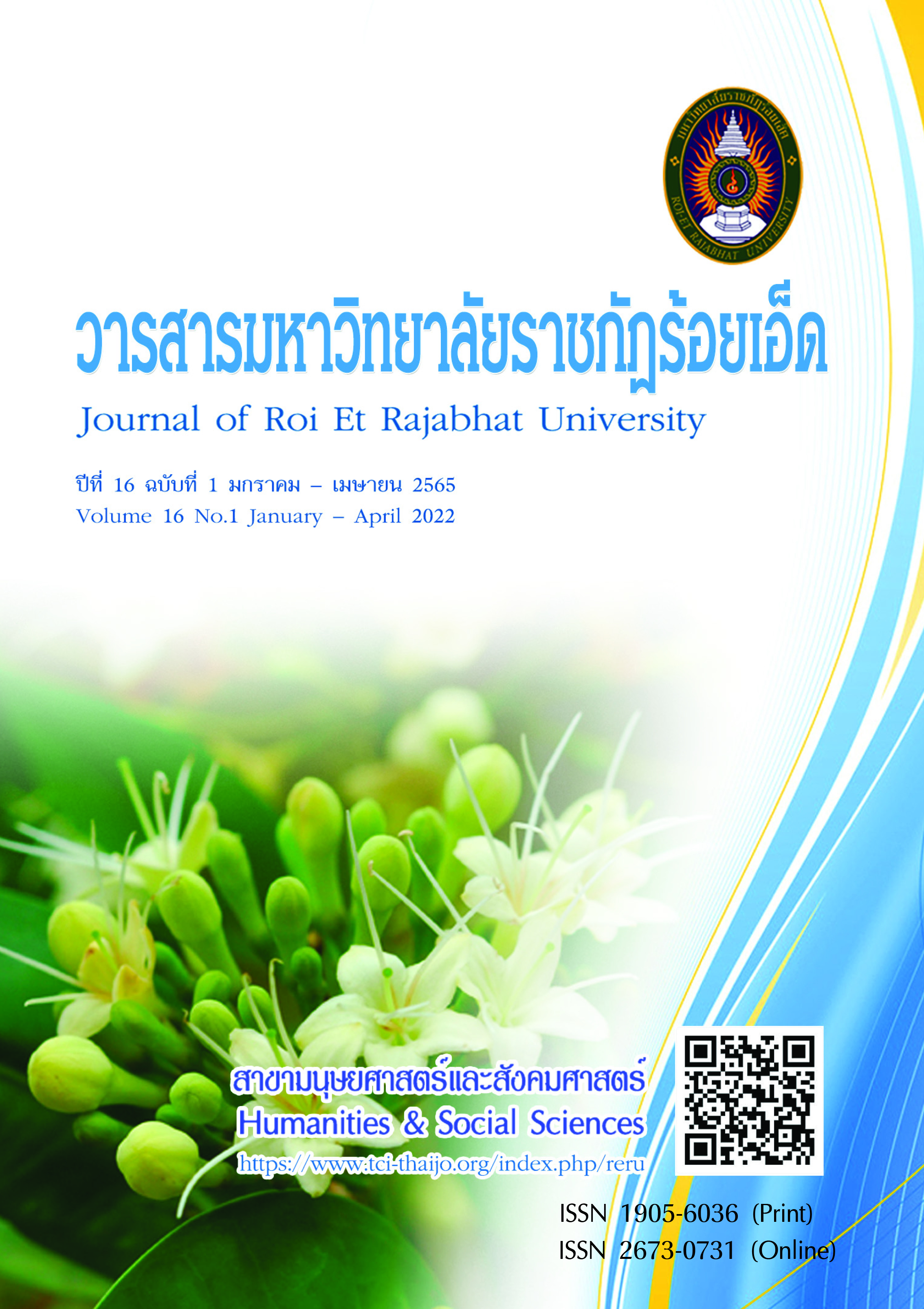A development of learning activities using collaborative learning with think-pair-share technique to promote Mathematical problem-solving ability on Interest and Value of money of Matthayomsuksa 5 students
Keywords:
Mathematical problem solving, Academic achievement, Learning Activity using Collaborative with Think-pair-share TechniqueAbstract
The purposes of this research were 1) to develop of learning activities using collaborative learning with think-pair-share technique with required efficiency of 70/70, 2) to compare learning achievement between using collaborative learning with think-pair-share technique and the conventional approach, 3) to compare problem-solving ability between using collaborative learning with Think-pair-share technique a conventional approach. The research samples consisted of 75 Mathayomsuksa 5/6 and 5/12 students attending Roi-Et Wittayalai School. They were assigned into experimental and control groups with 39 and 36 students respectively. The instruments used in this study were: plans for organizing of learning activities by using collaborative learning with think-pair-share technique and the conventional approach, those assigned for 9 plans in each approach; 25-item achievement test; and 5 items of mathematical problem-solving ability test. The statistics used for analysis of the collected data were mean, percentage, standard deviation and testing hypothesis with independent sample t-test.
The results of the study were as follows: 1) The plans for organizing the learning activities using collaborative learning with think-pair-share technique on Interest and money value had efficiency
of 77.95/72.31, which was higher than the criterion. 2) The students who learned by using collaborative learning with think-pair-share technique revealed higher learning achievement than those who learned
by using the conventional approach at the .01 level of significance. 3) The students who learned by using collaborative learning with think-pair-share technique revealed higher mathematical problem-solving ability than who learned by using the conventional approach at the .01 level of significance.
References
กระทรวงศึกษาธิการ. (2560). หลักสูตรแกนกลางการศึกษาขั้นพื้นฐาน พุทธศักราช 2551 (ฉบับปรับปรุง 2560). กรุงเทพฯ: โรงพิมพ์ชุมชุมสหกรณ์การเกษตรแห่งประเทศไทย.
ชวลิต ชูกำแพง. (2553). การพัฒนาหลักสูตรและการสอน (พิมพ์ครั้งที่ 2). มหาสารคาม: มหาวิทยาลัยมหาสารคาม.
นารีรัตน์ ประสมสาสตร์. (2562). ผลการจัดการเรียนรู้คณิตศาสตร์ด้วยการเรียนรู้เชิงรุกร่วมกับเทคนิคเพื่อนคู่คิดที่มีต่อความสามารถในการแก้ปัญหาและผลสัมฤทธิ์ทางการเรียนคณิตศาสตร์ ของนักเรียนชั้นมัธยมศึกษาปีที่ 3.
วารสารศึกษาศาสตร์มหาวิทยาลัยมกุฏราชวิทยาลัย, 7(2), 495-508.
พิมพันธ์ เดชะคุปต์ และพเยาว์ ยินดีสุข. (2551). ทักษะ 5 C เพื่อการพัฒนาหน่วยการเรียนรู้และการจัดการเรียนการสอนแบบบูรณาการ. กรุงเทพฯ: จุฬาลงกรณ์มหาวิทยาลัย.
รัชนี ภู่พัชรกุล. (2551). การเปรียบเทียบผลสัมฤทธิ์ทางการเรียนคณิตศาสตร์ของนักเรียนชั้นประถมศึกษาปีที่ 5 ระหว่างวิธีสอบแบบนิรนัยร่วมกับการเรียนรู้แบบร่วมมือเทคนิคเพื่อนคู่คิดและวิธีสอนแบบปกติ. วิทยานิพนธ์ การศึกษามหาบัณฑิต สาขาวิชาการมัธยมศึกษา. กรุงเทพฯ: มหาวิทยาลัยศรีนครินทรวิโรฒ.
วันวิสา ประมวล. (2555). การพัฒนาแผนการจัดการเรียนรู้ทักษะอ่าน คิดวิเคราะห์ และเขียนสำหรับนักเรียนชั้นมัธยมศึกษาปีที่ 1 โดยใช้เทคนิค KWDL Plus ร่วมกับการเรียนแบบร่วมมือเพื่อนคู่คิด. เพชรบูรณ์: มหาวิทยาลัยราชภัฏเพชรบูรณ์.
สถาบันทดสอบทางการศึกษาแห่งชาติ. (2562). ค่าสถิติพื้นฐานของคะแนนการสอบ O-NET ป.6 ม.3 และ ม.6 ปีการศึกษา 2561 จำแนกตามวิชา (คะแนนเต็ม 100 คะแนน). กรุงเทพฯ: สถาบันทดสอบทางการศึกษาแห่งชาติ.
สถาบันส่งเสริมการสอนวิทยาศาสตร์และเทคโนโลยี. (2561). คู่มือการใช้หลักสูตรกลุ่มสาระการเรียนรู้คณิตศาสตร์ (ฉบับปรับปรุง พ.ศ. 2560. กรุงเทพฯ: สถาบันส่งเสริมการสอนวิทยาศาสตร์ และเทคโนโลยี.
สุลัดดา ลอยฟ้า. (2537). เอกสารประกอบการสอนวิชา 215713 ปัญหา และวิธีการสอนคณิตศาสตร์. ขอนแก่น: มหาวิทยาลัยขอนแก่น.
Lyman, F.T. (1981). The Responsive Classroom Discussion: The Inclusion of all Students In. A.
Anderson (Ed.), Mainstreaming Digest. pp. 109-113. college Park: University of Maryland Press.
Polya. G. (1973). How to solve it. Princeton. NJ: Princeton University Press.
Downloads
Published
How to Cite
Issue
Section
License
Copyright (c) 2022 Roi Et Rajabhat University

This work is licensed under a Creative Commons Attribution-NonCommercial-NoDerivatives 4.0 International License.
บทความที่ได้รับการตีพิมพ์เป็นลิขสิทธิ์ของวารสารมหาวิทยาลัยราชภัฎร้อยเอ็ด
ข้อความที่ปรากฏในบทความแต่ละเรื่องในวารสารวิชาการเล่มนี้เป็นความคิดเห็นส่วนตัวของผู้เขียนแต่ละท่านไม่เกี่ยวข้องกับมหาวิทยาลัยราชภัฎร้อยเอ็ด และคณาจารย์ท่านอื่นๆในมหาวิทยาลัยฯ แต่อย่างใด ความรับผิดชอบองค์ประกอบทั้งหมดของบทความแต่ละเรื่องเป็นของผู้เขียนแต่ละท่าน หากมีความผิดพลาดใดๆ ผู้เขียนแต่ละท่านจะรับผิดชอบบทความของตนเองแต่ผู้เดียว





